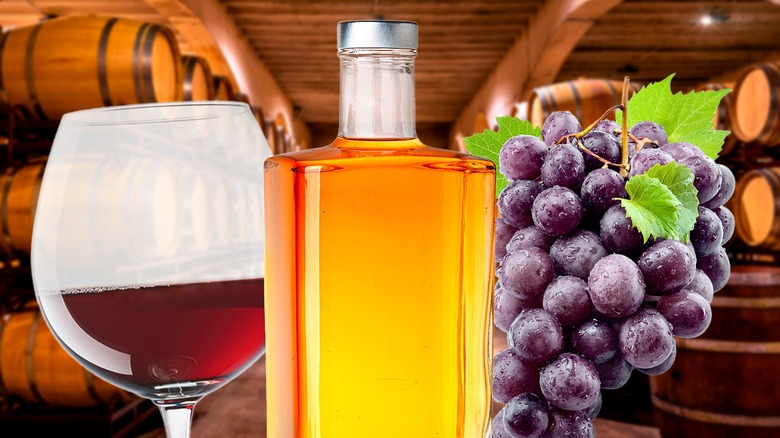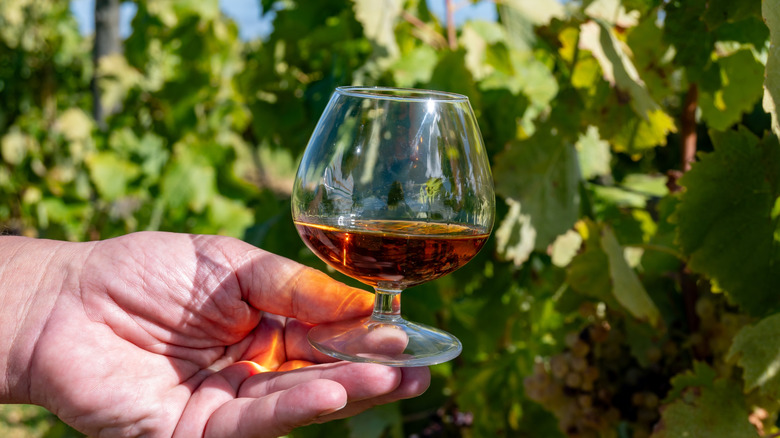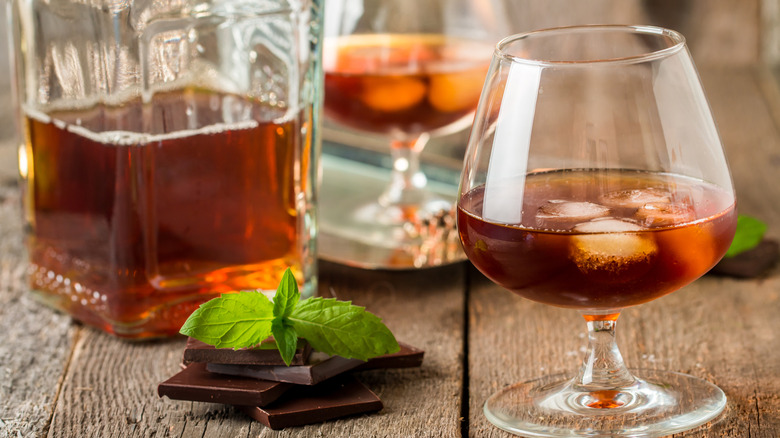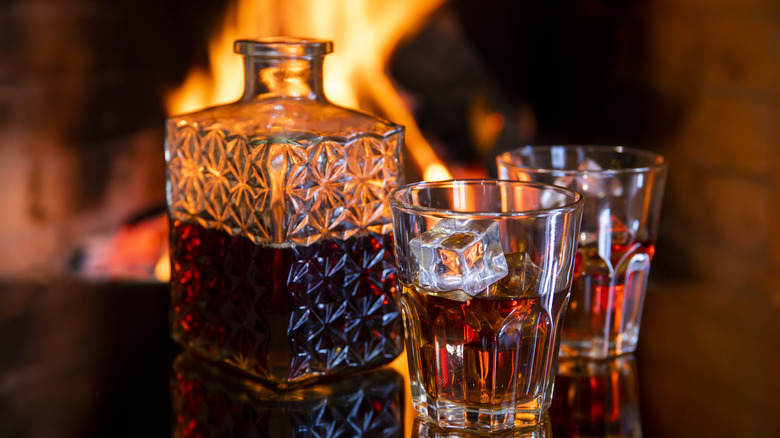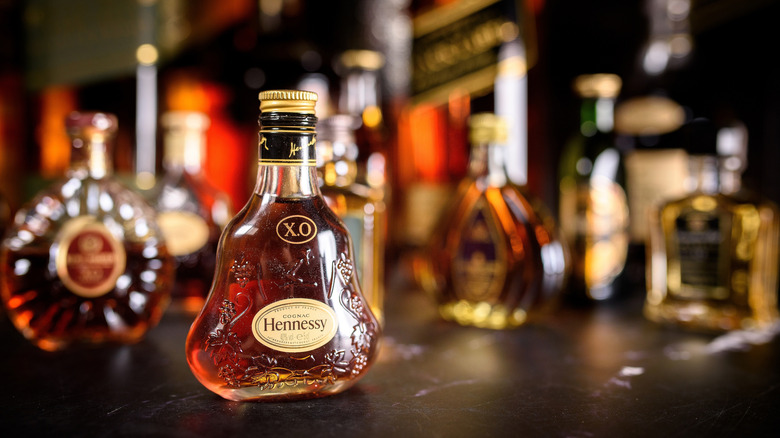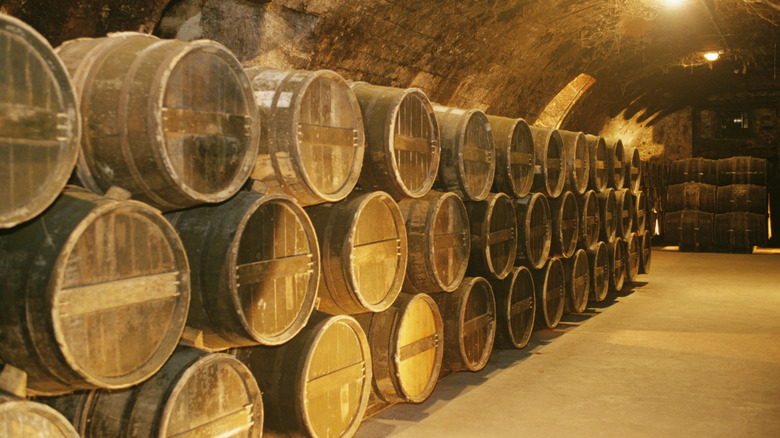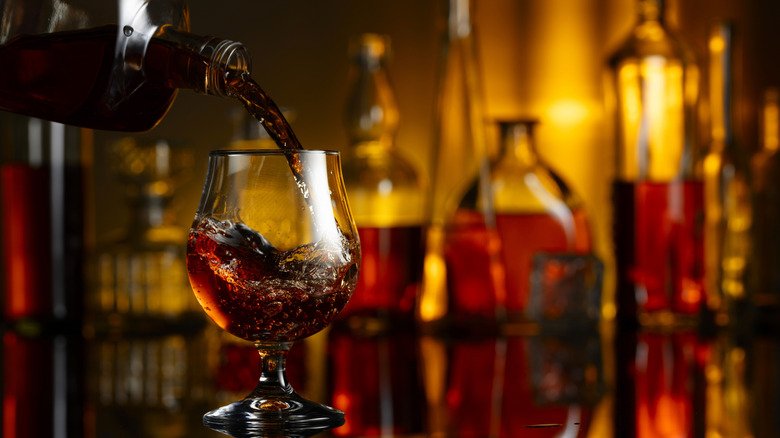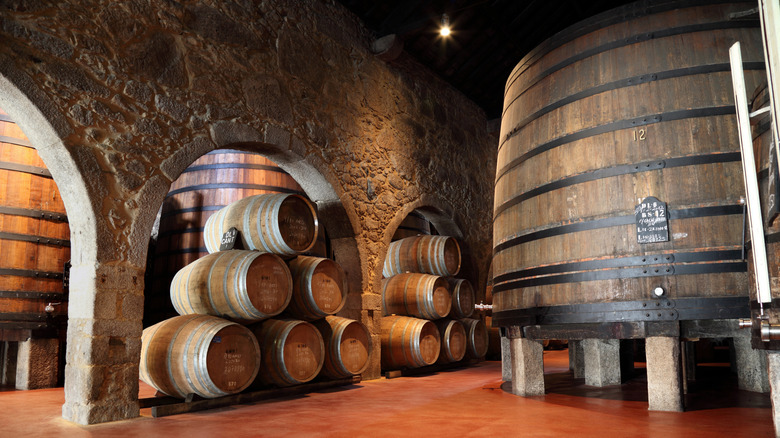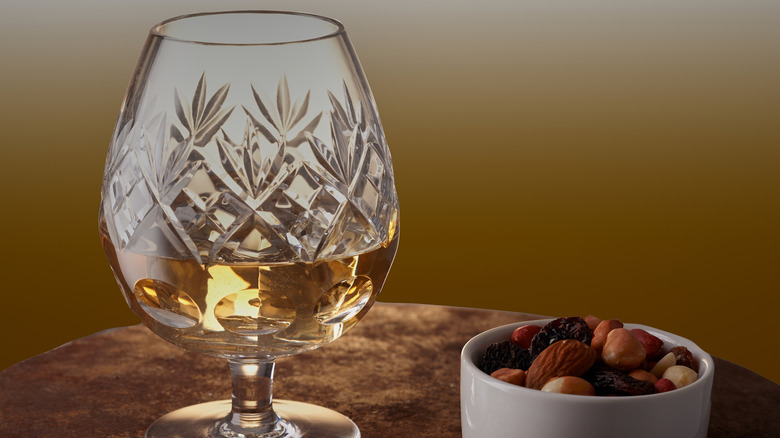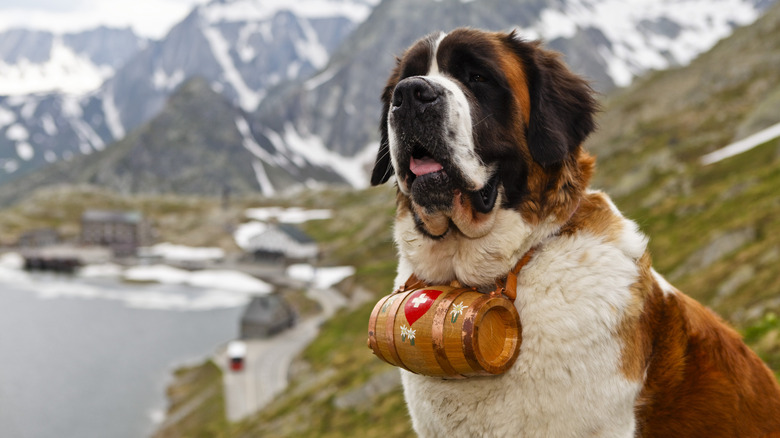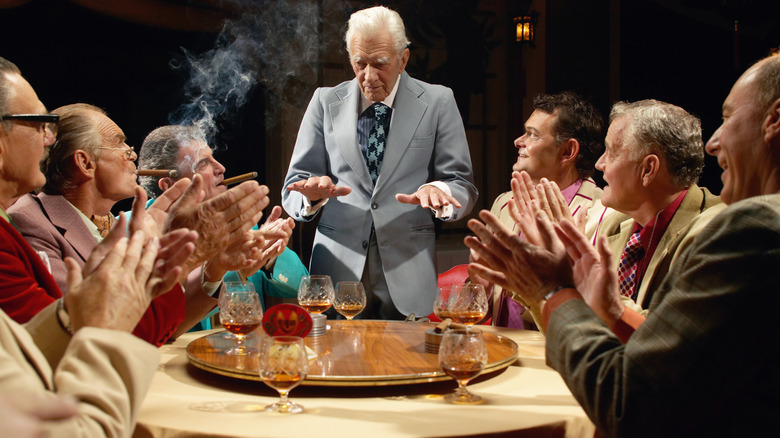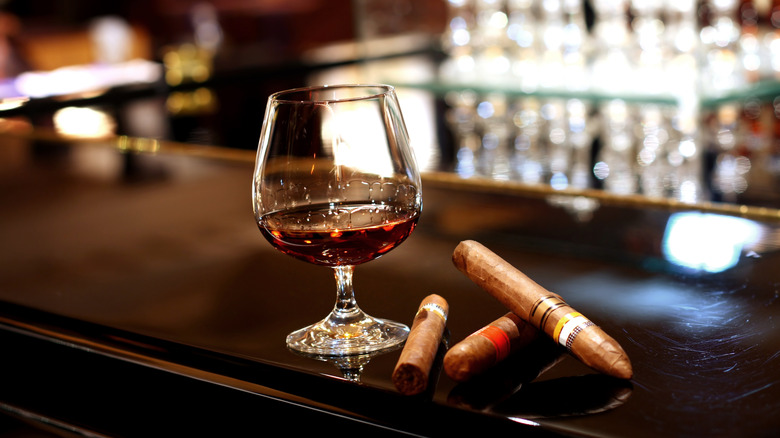11 Brandy Myths, Debunked
Like peppermint candy canes and mulled wine, brandy is one of those old-school foods and drinks you probably don't see around very much except around the winter holidays. Sure, you may have older relatives who enjoy a taste of it after dinner or you may see a bottle at your favorite bar, but you may not see the barkeep reaching for it very often. And unless brandy is your spirit of choice for spiking eggnog or curing a homemade fruitcake, you likely don't keep it around at home, either.
This is a shame because brandy encompasses a wider range of spirits than you may think — and can fit into your home mixology and cooking in any number of fun and surprising ways. The term brandy is a blanket term for distilled spirits made from wine, and can take forms from young, clear, and fruity to aged, dark and oaky. So, if you think you don't like brandy, you probably haven't tried the right one yet. To give us a guided tour through the world of brandy, we've enlisted four experts: Draga Culic, founder of Blacklisted Brandy; Justin Stiefel, co-founder, CEO, and master distiller at Heritage Distilling Company; Caitlin Bartlemay, master distiller at Clear Creek Distillery; and Chris Finnegan, director of Cocktail Crates.
1. Myth: All brandy is made from grapes
The brandy types most familiar to American drinkers — that is, those that are easy to find in stores and typically make their way into eggnog — are based on grape wines. "If the label states it's a brandy without specifying the fruit type, then it means it's a grape-based brandy, which is the majority of the category," Draga Culic explained. All brandies, Culic said, undergo two fermentation processes: an initial process in which the fruit is made into wine, then a distillation process in which the wine's alcohol and flavor compounds are concentrated into brandy.
But while grape-based brandies are the default in the U.S., this is far from the case elsewhere in the world. "In Serbia, brandy-making is a centuries-old tradition using plums, quince, pears, raspberries, and apricots," Culic said. Chris Finnegan added that he's encountered brandies made from other fruit as well, including apples, cherries, and peaches. Each offers its own distinct flavor profile, so if brandy has left you cold in the past, varieties made from different fruit might be worth exploring.
2. Myth: Brandy is different from Cognac or Armagnac
A possible reason brandy tends to fly under the radar of most American drinkers is that it goes by numerous different names, depending on where and how it is made. This means it's quite possible you've enjoyed brandy in the past without realizing it actually was brandy.
For example, most people know Cognac and Armagnac as refined French spirits, typically sipped from globe-shaped snifters after fancy meals. Both, however, are in fact types of grape brandy. "Cognac comes from the Cognac region in southwestern France," Draga Culic said. "It is distilled twice and must be aged for at least two years." In contrast, Culic explained, "Armagnac is made from grapes in the Armagnac region of France and is only distilled once." Meanwhile, brandies with roots elsewhere in the world have their own cultural names: Kirschwasser, for instance, is a dry cherry-based brandy with roots in Germany and Switzerland, where it's a standard ingredient in dishes including cheese fondue and Black Forest cake. (If you prefer a sweeter, lower-proof cherry brandy, try Maraschino.) And Slivovitz is plum brandy beloved in Eastern Europe.
3. Myth: The darker the brandy, the more flavorful it is
Another common myth about brandy is that its color reflects its quality. Typical grape brandies as well as grape brandy varieties such as Cognac and Armagnac have a warm brown hue, much like that of whiskey, and casual drinkers often believe this color to be an effect of barrel aging — so the deeper the color, the longer the brandy has aged in an oak barrel and the better the brandy.
Our experts noted, however, that this is not always true. While a deeper color can be a reflex of aging, other factors can affect color as well. "Color for any spirit category has been used, incorrectly in my opinion, as an indication of the quality of the spirit," Caitlin Bartlemay said. "Caramel coloring is allowed in many categories to help producers hit a consistent color across their productions over time, as it does change depending on the barrels, spirit, and climate for maturation." She also pointed out that many fruit brandies are intentionally made to be clear — so trust your palate, not your eyes, when evaluating brandy.
4. Myth: Good brandy is always super-expensive
For a long time, brandy, especially certain types of Armagnac and Cognac, had a reputation as the tipple of the ultrawealthy. Picture a typical Cognac lover, and the image of an older, suit-clad man in an armchair by a fireplace comes to mind. And some varieties, especially long-aged, rare vintages, do command jaw-dropping prices, sometimes in the thousands of dollars. "Some of the high-end brandies do use rarer blends with older vintages, these can't be produced on the same scale as cheaper options which will of course reflect in the cost," Chris Finnegan said.
But if you have an ordinary mortal's budget and are more interested in great flavor than a great pedigree, you're in luck. "There are some great brandies out there for a reasonable price," Finnegan said. "Typically over Christmas, you can get some great deals on any type of alcohol so you can expect to find a decent bottle for £30-£40 ($38-$50) if you shop around." Still, be aware that good-quality brandy won't be dirt cheap. "If you enjoy a clean, additive-free brandy, know that it typically takes about 30 pounds of fruit to create just one bottle of brandy," Draga Culic said. "A good sweet-spot would be around $50 to $60 for an unaged brandy, and around $70 for an aged brandy for a quality brandy."
5. Myth: To make great brandy, you must start with great wine
Some drinkers believe that fine brandies command high prices because they're distilled from premium wines. This, however, is a myth. "For French brandies, the wine that is distilled would not be something you would like to find in your glass," Caitlin Bartlemay said. "It is usually quite acidic, a lower-percentage ABV, and a bit thin. In other regions, their brandy is made from the same wine you might expect to share with friends over dinner." In short, grape brandy is a rare exception to the coder's adage "garbage in, garbage out"— the principle that you must start with high-quality components to end up with a high-quality product.
Indeed, while reputable winemakers are choosy about the varieties of grapes they use, brandy distillers have embraced a surprisingly wide range of grape varietals. For instance, Draga Culic explained that while the rules governing the production of Cognac are strictly controlled (it must use white grapes, generally ugni blanc, Folle blanche, or Colombard varieties), brandy makers elsewhere can and have used any grapes they could find. "Brandy grapes range from Riesling to Baco Noir to Pinot Noir to Thompson Seedless grapes from California — the list is endless, really.," Culic said.
6. Myth: Brandy never changes once it's bottled
Because some brandies are aged for years or even decades, drinkers often assume that a bottle can last forever. And it's technically true that brandy stops aging once it's bottled. "Aging only happens when the spirit is in contact with wood, drawing out complex flavors and aromas," Justin Stiefel explained. "Once removed from contact with wood, that process is done. When the brandy is put into glass bottles the bottle acts as a stable, airtight environment, so what you get on day one of bottling is what you'll get 10, 20, or even 50 years later."
But Stiefel added that this is only true if a bottle remains unopened and stored in a cool, dark environment away from direct sunlight. And once the seal on the bottle is broken, all bets are off. "Once exposed to oxygen, brandy slowly oxidizes, which can lead to subtle changes in flavor and aroma over time. Also, as the volume in the bottle drops, the alcohol in the spirit can evaporate since alcohol is volatile. It won't spoil like perishable foods, but it can lose some of its character if not stored properly." Draga Culic, however, noted that fans of clear, unaged fruit brandies find these become mellower and more refined over time. "This, to a lesser extent, slightly mimics the resting period in stainless steel vats, where the chemical process refines and balances out the spirit," she said.
7. Myth: Older brandy is always better
A certain air of mystique surrounds long-aged brandies — and often for good reason. "Older brandies spend years or even decades in oak barrels, during which time they develop exceptional depth and complexity," Justin Stiefel explained. "The cost also reflects the time and resources it takes to store and maintain aging barrels." Adding to their rarity is the natural process of evaporation that takes place during aging. "Depending on storage conditions, for barrels aging 20 years, 30 years or more, it is not uncommon to lose more than half the volume in the barrel, cutting in half the expected yield and more than doubling the effective cost of production," Stiefel said.
However, not all brandies benefit from aging. "In the case of many fruit brandies, they are released un-aged and crystal clear because the crisp and pure expression of the fruit was the goal of the distiller in the first place," Caitlin Bartlemay said. Thus, Bartlemay noted, the assumption that older and oakier brandies are always better is also untrue. "There are some flavors that develop over extended aging that some might find enticing, and others would find off putting," she said.
8. Myth: Brandy is only good for sipping
One thing that may scare some people away from brandy is the myth that it's only intended for serious sipping. "This myth is holding brandy back," Justin Stiefel said. "Yes, sipping a well-aged brandy neat is a beautiful experience. But don't let that limit you. Brandy works great in cocktails — from classics like the Sidecar [made with brandy, Cointreau, and lemon juice], to modern twists like brandy sours and craft punches, it's a flavor powerhouse."
Our other experts also praised brandy's versatility. "Brandy can actually be subbed out for whiskey in a lot of classic cocktails," Caitlin Bartlemay said." There is nothing wrong with a brandy Old Fashioned, a brandy Boulevardier, or a brandy Paper Plane (I love an apple brandy Paper Plane specifically)." And Draga Culic pointed out that brandy was historically a standard base for cocktails. "I like to remind people that a third of our classic cocktails were originally made using brandy as the base spirit, so it was the spirit of choice before Prohibition came around and knocked it off its pedestal," she said. And, she added, it deserves more attention from modern mixologists. "It's not as dense as some other base spirits can be in cocktails. You can swap it out one-for-one for tequila, gin, vodka, bourbon, or any aged spirit without having to add a lot of sugar or sweetener to balance it out because it's fruit-forward."
9. Myth: St. Bernards in the Alps once carried barrels of brandy around their necks
Among the few images of brandy in the public imagination is the old image of large, friendly St. Bernards serving as rescue dogs in the snowy Alps, each wearing a small barrel filled with brandy around its neck. The image has some basis in reality: Historically, an order of monks in a mountainous region near the Swiss-Italian border kept the large dogs (formerly known as Alpine mastiffs) as watchdogs, and later as rescue dogs to search for and assist travelers who ran into trouble in the treacherous trails.
What the dogs never had, however, were barrels of brandy. The iconic barrels were the brainchild of British artist Edwin Landseer, who'd never been to the Alps but had a fascination with St. Bernards. His most famed painting, "Alpine Mastiffs Reanimating a Distressed Traveler," featured two of the dogs coming to the rescue of a clearly hypothermic man — and one of them wore a barrel attached to its collar. (Why Landseer painted the barrel is anyone's guess.) For the safety of freezing hikers, however, it was probably a good thing the real dogs didn't carry brandy. While alcohol can make one feel warmer in the short term, it contributes to further heat loss and can impair one's judgment. Instead, the dogs used a safer and more practical tool to revive frostbitten travelers: their own warm, furry bodies.
10. Myth: Brandy is just for old people
An unfortunate (and ageist) myth that turns some away from brandy is that it's a drink for old people. "This one always makes me chuckle," Justin Stiefel said. "One might associate brandy with cigar lounges and old-school decanters, but that's a narrow view as brandy is incredibly versatile." When we consider the range of forms brandy can take, from serious aged Cognacs to clear, young fruit brandies, this versatility becomes even more clear. "It can be as refined as a top-shelf whiskey or as playful as a fruity cocktail base," Stiefel said.
And just as today's younger generations have embraced trends once associated with seniors, such as flip phones and crochet, some are also starting to rediscover brandy. "We're seeing younger generations discover brandy as a fresh alternative to rum and whiskey in mixed drinks — a brandy old-fashioned, for example," Stiefel said. Draga Culic also sees brandy having a moment with younger drinkers. "For Gen Z, a generation that values authenticity and transparency, brandy is where it's at," she said. "Many other spirits categories hide behind other ingredients or can't be sipped neat, but brandy can do it all."
11. Myth: Brandy snifters are just for show
By tradition, different drinks are served in different glassware. Sparkling wine, for instance, feels most festive when served in a traditional tall, narrow flute, and your local craft brewery typically serves its wares in sturdy, plain pint glasses. And when we think of brandy connoisseurs, we think of distinguished elders cradling round, stemmed snifters holding their tipple of choice.
These old-school snifters may seem like a pretentious affectation. But if you're going to enjoy an aged brandy the traditional way, by sipping it neat, a snifter can help you get the most from the experience. "The wide bowl allows for more surface area, encouraging evaporation of the spirit's volatile compounds," Justin Stiefel said. "The narrow top concentrates the aromas, so when you bring the glass to your nose, you get a fuller experience of the brandy's bouquet. Swirling the brandy releases even more aroma compounds." All of this, Stiefel said, gives you "a preview of the flavors you're about to taste."
